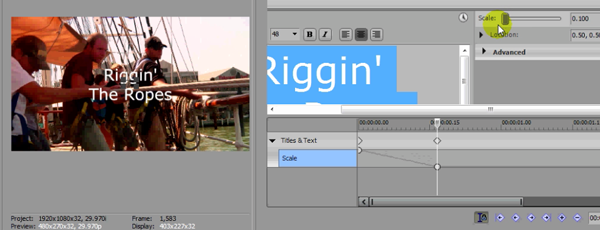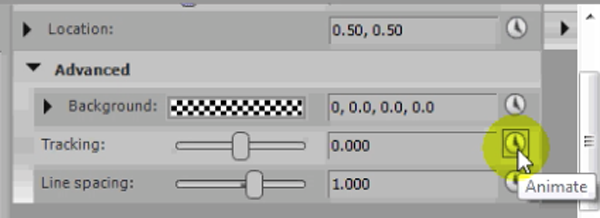Animating Effects with Per-Parameter Keyframes in Sony Vegas Pro 11
In this tutorial you'll learn how to make the most of Vegas's new by-parameter keyframing capabilities for effects plug-ins that ship with Vegas Pro 11 using the new Sony Text & Titles plug-in as an example.
But for right now, let's just stick with Scale. It's important to turn on Sync Cursor to Media Timeline when you're doing this type of work, because that way, no matter where you are in either timeline-that is, the plug-in timeline or the Vegas timeline itself--they'll stay in sync with each other (Figure 8).

Syncing cursor to timeline to keep the timelines in sync
Adding Animation
So let's to start with the first keyframe (the solid white circle at the left edge of the Scale timeline in Figure 7). In your own projects, if you haven't added any animation to any parameter, you will see in the timeline here there's no other keyframes, so that's all you'll have.
To begin working with that first keyframe, let's bring our scale out until our text is as far off the screen as it can get (Figure 9). This is where we start.

Scaling the text off the screen to start
Move forward in time just a little bit. As you move your Scale slider, you'll see that the text moves, near and far, and you'll also see that the rubber band in the keyframe moves up and down (Figure 10).

With the text scaled down (and appearing farther away by comparison), the keyframe rubberband in the timeline also moves up and down between keyframes.
For this exercise, let's move it until the text is on the screen at about what we think is the right point, which is about 10% of its highest point. Then press Shift+B to render the event to RAM and see what that looks like.
You'll see in the clip above that the text kind of pushes on screen. Now, if you wanted the text to appear on screen faster, you could just click and drag your keyframe more towards the beginning of the event (Figure 11). Render that to RAM and see what it looks like, and you'll see that it pops on screen really fast. That's the kind of bold, dramatic entry we want, so let's keep it right there.

Moving the keyframe closer to the beginning of the Event so the text pops on screen faster
Animating Tracking
Now that we've animated the scale of our text, let's animate something else. Click on the Advanced button and click the Animate button next to Tracking (Figure 12). That brings up a new timeline and a new rubber band for the tracking parameter.

Animating the Tracking parameter
Now, notice that if you just start manipulating the slider that you start affecting the tracking of the text from the very beginning of the event. In this example we don't want to do that (Figure 13). We want the text to appear fully on screen first. So our second keyframe is going to be the exact same as the first. That way the tracking is held through the entire time that the text appears on screen.

Tracking the text before it fully appears on-screen
Once the text has appeared on screen, we'll add another keyframe here and we'll adjust our tracking (Figure 14). Experiment: Bring it out. Go a little bit further in time, then bring it back. Go a little further in time, then bring it in, and so on, just to see how the tracking is affected over time as you adjust your keyframe.

Adjusting the tracking after the text has fully appeared
Related Articles
A quick look at the latest new features in Sony Vegas Pro 13, including the Vegas Pro Connect iPad app, a proxy-first workflow for mobile and 4K editors, and true, four-range loudness meters.
David McKnight demonstrates a quick, easy way to generate sharp-looking titles for your Vegas Pro projects that requires no additional plugins.
Vegas Pro 12, the new version of Sony's flagship NLE that debuted a few weeks ago, boasts several new features for online video production pros including simplified color matching, advanced mask creation and manipulation, and increased 64-bit support, while shipping as part of a new suite that includes Sound Forge Pro 10 and the HitFilm 2 Ultimate effects package.
In this fifth tutorial in our six-part series on Sony Vegas Pro 11, we're going to talk about the Render dialog box. Every project you work on, whether it's delivered on the web, or even on DVD or Blu-ray Disc, has to go through a rendering stage, so you'll find yourself getting quite familiar with it as you do more project. In Vegas Pro 11, Sony has added some new features to the Render dialog, and they've totally revamped the way that it works.
The new mixer layout in Sony Vegas Pro 11 makes editing audio for video in Vegas feel like you're using a pro hardware mixer. Vegas instructor David McKnight explains how it's done.
Sony Vegas instructor David McKnight continues his video tutorial series with a look at Vegas' new GPU Assist feature, which enables Vegas editors to leverage the processing power of supported NVIDIA and AMD video cards to get full-frame previews of loaded timelines and accelerate rendering with many popular codecs.
Sync Linking is a cool new feature in Sony Vegas Pro 11 that allows you to group clips of events and move and control them in the timeline with a single Master clip, while still being able to fine-tune subordinate clips within the group.